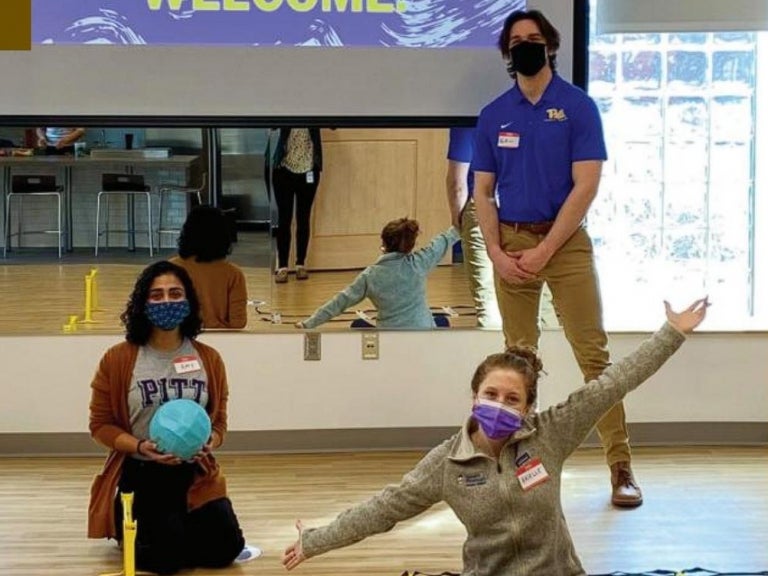
In the Department of Physical Therapy (PT), new initiatives are in place to ensure its number-one ranked program is also at the forefront of increasing enrollment of underrepresented and disadvantaged students.
The department has initiated an educational pipeline to recruit a more diverse student body, adopted a more holistic admissions process and added a hybrid option for students in the Doctor of Physical Therapy (DPT) program.
Assistant Professor Tara Ridge-Hankin says ADaPT@Pitt began in August to recruit minority and underserved undergraduates who may be interested in health care careers, particularly physical therapy. “We want to create a pipeline of highly qualified, diverse individuals who will be ready and able to tackle the demands of the DPT program.”
Ridge-Hankin explains that the program started with a social media campaign to engage with Black and Hispanic students as well as students who may have socio-economic barriers that prevent them from attending graduate school, or other concerns that limit their ability to enroll.
“Our goal is to get to know these students, offer seminars and panel discussions throughout the year to inform them and eventually connect them with mentors in the field,” says Ridge-Hankin.
This summer, students will have the opportunity to attend a week-long intensive experience on campus that will include networking opportunities, peer mentorship, academic counseling, clinical observation and application support services including meetings with financial aid officers.
“We know there are qualified students from underserved and underrepresented communities who, for one reason or another, never apply to our program,” observes Ridge-Hankin. “Through ADaPT@Pitt, we hope to identify them and get them into the educational pipeline.”
David Wert, vice chair of DPT Education and associate professor, says a more holistic approach to the admissions review process that accounts for an individual’s life experiences also impacts the number of diverse candidates accepted into the program.
“In the past, we relied on traditional metrics such as the Graduate Record Examinations (GRE), a high number of observation or volunteer hours, and the applicants’ Grade Point Average (GPA),” notes Wert. “However, there are biases in these metrics that sometimes caused us to overlook the potential of some applicants.”
Wert says that since the department eliminated the need for GRE results during the 2021-2022 application cycle, the applicant pool increased by 100.
“We are also now reviewing the observation or ‘shadowing’ hours within the context of the individual applicant, considering their unique circumstances and situations accordingly,” he adds. “Although we still use GPA as a predictor of success, we encourage our reviewers to look at each applicant’s full undergraduate experience in an effort to better understand the academic journey and potential of the applicant, and to recognize the challenges students faced and the efforts put forth amidst such challenges.”
Through the new DPT-Hybrid option, students from diverse circumstances and locations can earn this sought-after degree.
Professor Kim Nixon-Cave serves as director of the DPT-Hybrid offering. She’s one of eight new faculty members from across the country who were hired to implement the new model.
“Pitt has been developing the hybrid concept for several years and we’re very excited to have our first cohort in place,” says Nixon-Cave. Right now, 23 students are enrolled with the goal of the hybrid option enrolling 90 students for fall 2022.
“This is not ‘pandemic teaching,’” she points out. “Our hybrid option follows a very thought-out, well-designed curriculum that is supported by instructional designers, videographers and all the necessary resources to develop the curriculum. It is top-notch, as you would expect from the Pitt DPT program.”
The option includes both synchronous and asynchronous learning as well as two, six- to 10-day immersion sessions on campus each semester for hands-on instruction and to facilitate the course material presented online. Hybrid students will have the opportunity to complete their clinical rotations in their hometowns if they choose.
Nixon-Cave says one of the most favorable aspects of the hybrid option is that the students pay in-state tuition. “Physical therapy education is quite expensive and this model helps eliminate some of the financial burden.”
But there’s another benefit. Nixon-Cave hopes some of the hybrid students will remain in their hometowns to practice after they receive their degree, providing services to people who may currently lack access to health care, specifically physical therapy.
According to PT Department Chair and Professor James Irrgang, “Ultimately, all of these changes will enhance the diversity and inclusion of the PT profession and improve the quality and outcomes of care provided to individuals seeking care from physical therapists.”
Read more in FACETS Fall 2021.
